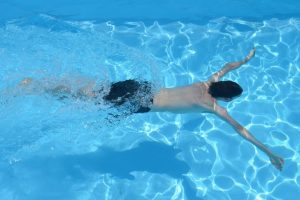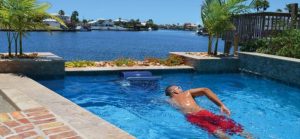Why should you swim?
It is common knowledge that swimming is one of the most complete sports, as all muscle groups are involved during the exercise; furthermore it is a sport that injuries are uncommon. As water reduces body weight, joints will suffer less impacts and therefore injuries.
Being a low-impact sport for joints and all major muscle groups, it is considered an ideal sport for injury rehabilitation.
 Therefore swimming should be a recommended exercise to practice to everyone, regardless of age, physical condition, or even for injured people who typically will not have the chance to exercise themselves in another medium.
Therefore swimming should be a recommended exercise to practice to everyone, regardless of age, physical condition, or even for injured people who typically will not have the chance to exercise themselves in another medium.
Where can you swim?
However, swimming in some cases might require complex logistics as there are not many places you can swim in. There are different places in which to swim, each of them with pro and cons:
1.Public swimming pool, depending on how far you leave from the pool it might be difficult to find the time to get to the lap pool. Then you will share a lane with other people who will swim at different speeds, making it in some cases a stressful experience
2. At the sea or in a lake. From a safety point of view not recommended.
Spain is the country in Europe with a higher number of swimming pools. Weather is the main contributor to encourage people to install a pool in their backyard. All these pools, in most of the cases are used for leisure activities, and not intended to carry out a physical exercise with will help us to maintain our health in top condition.
Novelty, swimming in small pools
What if we could use our house or our friend’s house swimming pool, to swim even better than in a public lap pool?
In order to achieve this, several companies are developing methods of counter-current swimming, i.e. water propulsion systems that generates a continuous stream of water in a pool, allowing users to swim against the stream being stationary. As a result, the required size for the pools is pretty small. To make an analogy, it would be like using a treadmill at home instead of jogging in the park.
Systems for swimming in small pools
There are different systems that will allow swimming in small pools. Depending of the swimming level and budget, these systems are mainly divided into 2 types:
1. Swimming systems using elastic bands. The elastic bands are placed around the swimmer waist or legs, the movement when swimming is neutralized by these elastic bands, allowing the swimmer to stay stationary. It is a cheap and effective method, but it has several drawbacks:
1. Since there is no water current running through the swimmer body, the buoyancy is not as strong as compared to “standard” swimming. Therefore the body position when swimming will not be ideal and the swimmer should also fight against the inertia of the bands. With this system is normally difficult to swim for more than a few minutes as it is usually a pretty tough job to swim against the resistance of the elastic bands. It is not recommended for just-started swimmers
2. It is also a single “speed” method, cannot swim slower or faster, we always swim at the “speed” that marks the resistance of the rubber band.
3. The swimming technique will not be ideal, because we have to balance the lack of buoyancy that provides the aquatic environment: This is achieved, by increasing the stroke rate because in between the stroke cycle the buoyancy is lost, in combination with a forced swimming position in the front quadrant, i.e., with the center of gravity moved forward, and with a feet shake more generous than usual. In short words, we will be swimming in a forced position. Depending on the physiognomy of the swimmer and the effort that is put in the exercise we could even reach to the point to injure ourselves. It is therefore not recommended to exercise everyday using this method
2. Counter-current swimming systems with water propulsion. In these systems, one or more jets of water are released from the wall of the pool, generating a continuous stream. If we swim against the stream at the same speed that the current, the swimmer will stay stationary and the water will flow under the swimmer body generating the same buoyancy as when swimming in a conventional lap pool or in the sea. The impressive thing is that all this can be achieved using our own pool, which requires no dimensions longer than 4-5 meters. Within the counter-current swimming systems using water propulsion, we can find two main systems:
 1. Counter-current swimming systems using jets, In these systems, one or more jets of water are released from the pool wall, generating a continuous stream of water with bubbles, similar to a “jacuzzi”. From a point of view of swimming technique, these systems have the disadvantage that the water current is bubbly water causing an artificial lift when swimming. On the other hand, the natural tendency is to be as close as possible from the jet so that the effect of counter the speed of swimming is more effective, this actually can turn to be a bit “stressful” because the closer you get to the water jet, the greater is the number of bubbles that will be hitting your face. Also, if we are thinking of placing mirrors on the bottom / side of the pool to improve swimming technique, the bubbles will hinder the vision of the swimmer. As for the benefits, these systems might provide the relaxing effect of the “jacuzzi” jets type. This type of system also allows regulating the speed of the current so you do not to be an advanced swimmer to use this system, there is always a current speed adequate for you.
1. Counter-current swimming systems using jets, In these systems, one or more jets of water are released from the pool wall, generating a continuous stream of water with bubbles, similar to a “jacuzzi”. From a point of view of swimming technique, these systems have the disadvantage that the water current is bubbly water causing an artificial lift when swimming. On the other hand, the natural tendency is to be as close as possible from the jet so that the effect of counter the speed of swimming is more effective, this actually can turn to be a bit “stressful” because the closer you get to the water jet, the greater is the number of bubbles that will be hitting your face. Also, if we are thinking of placing mirrors on the bottom / side of the pool to improve swimming technique, the bubbles will hinder the vision of the swimmer. As for the benefits, these systems might provide the relaxing effect of the “jacuzzi” jets type. This type of system also allows regulating the speed of the current so you do not to be an advanced swimmer to use this system, there is always a current speed adequate for you.
2. Counter-current swimming systems with running water. In these systems, equipment is placed in the pool wall; it will generate a continuous stream of water free of bubbles and turbulence. Such a system is the ideal system for swimming at any level, from beginners to Olympic swimmers. The main advantage provided for swimmers is that the swimming experience is far better that swimming in an Olympic pool but in your own home! Swimming sensations for starters and advanced swimmers in such systems are even better than in a 50 meter lap pool since you do not have to worry because there is a wall in front of you every 50 meters and of course you do not have to share the lane with any other swimmers. This allows the swimmer to concentrate exclusively on the swim and the feelings that emerge from the counter current swimming. As the system is turbulence and bubbles free, visibility is perfect for placing mirrors on the bottom and / or side of the pool. This allows unparalleled experience, because the swimmer can concentrate on improving technique or simply swim! This type of system allows regulating the speed of the current so the swimmer does not have to be an advanced swimmer to use this system. Since you will quickly improve your technique and therefore your swimming speed, system can have as much as 100 different speeds so that you can easily set a training scheme and monitor the improvements
In SmartPools we are dedicated to reinvent the way you use your pool, that is, give it a new added usage to the traditional leisure usage that usually occurs only during the summer. You can turn your pool into one of the most attractive elements of your home, using it to train your body, enjoy your free time, and keep your health in perfect condition.
Counter-current swimming systems with running water
[product_category category=”stationary-swimming”]